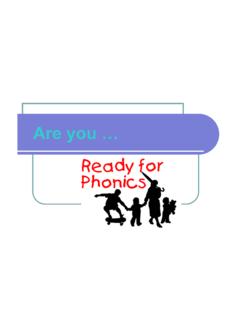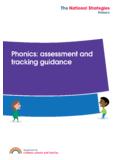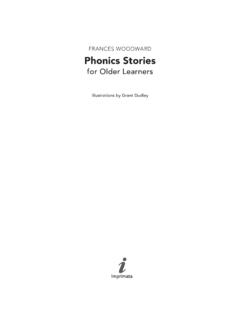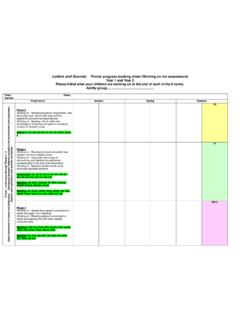Transcription of Letters and Sounds - assets.publishing.service.gov.uk
1 Letters and Sounds :Principles and Practice of High Quality PhonicsPhase One Teaching ProgrammeRef: 00113-2008 BKT-EN00113-2008 BKT-EN Crown copyright 2008 Letters and Sounds : Phase One Teaching ProgrammeThe National Strategies | PrimaryLetters and Sounds : Phase One1 Letters and Sounds :Principles and Practice of High Quality Phonics Phase One Teaching ProgrammeFirst published in 2007 Second edition 2008 This publication was originally produced as Ref: 00281-2007 BKT-EN This edition comprises the phase one teaching programme only Ref: 00113-2008 BKT-EN2 Letters and Sounds : Phase One Teaching ProgrammeThe National Strategies | Primary00113-2008 BKT-EN Crown copyright 2008 Letters and Sounds : Phase OneIntroductionLetters and Sounds is a six-phase teaching programme designed to help practitioners and teachers teach children how the alphabet works for reading and spelling.
2 It was published in April 2007 and has been widely distributed to local authorities, schools and settings. Since its publication there has been widespread recognition that it would be useful to have a separate and more compact publication that comprised just the first phase of the programme (Phase One). This publication fulfills that need and is intended particularly for use by childminders, those working in private, voluntary and independent settings and other early years provision. Phase One activities concentrate on developing children s speaking and listening skills, phonological awareness and oral blending and segmenting.
3 These activities are intended to be used as part of a broad and rich language curriculum that has speaking and listening at its centre, links language with physical and practical experiences, and provides an environment rich in print and abundant in opportunities to engage with books. Phase One activities pave the way for children to make a good start in reading and writing. The materials presented here comprise the Phase One programme, a DVD showing clips of effective Phase One practice and a short booklet of overall Crown copyright 2008 Letters and Sounds : Phase One Teaching ProgrammeThe National Strategies | PrimaryLetters and Sounds : Phase One3 Phase OneNotes for practitioners and teachersPhase One falls largely within the Communication, Language and Literacy area of learning in the Early Years Foundation Stage.
4 In particular, it will support linking Sounds and Letters in the order in which they occur in words, and naming and sounding the Letters of the alphabet. It also draws on and promotes other areas of learning described in the Early Years Foundation Stage (EYFS), particularly Personal, Social and Emotional Development and Creative Development, where, for example, music plays a key part in developing children s language. Phase One contributes to the provision for Communication, Language and Literacy; it does not constitute the whole language activities in Phase One are mainly adult-led with the intention of teaching young children important basic elements of the Letters and Sounds programme such as oral segmenting and blending of familiar words.
5 However, it is equally important to sustain and draw upon worthwhile, freely chosen activities that are provided for children in good early years settings and Reception classes. The aim is to embed the Phase One adult-led activities in a language-rich provision that serves the best interests of the children by fully recognising their propensity for play and its importance in their follows that the high quality play activities which typify good provision will offer lots of opportunities to enrich children s language across the six areas of learning:Personal, Social and Emotional Development Communication, Language and Literacy Problem Solving, Reasoning and Numeracy Knowledge and Understanding of the World Physical Development Creative Development.
6 Practitioners and teachers will need to be alert to the opportunities afforded for language development through children s play, and link learning from the Letters and Sounds programme with all six and Sounds : Phase One Teaching ProgrammeThe National Strategies | Primary00113-2008 BKT-EN Crown copyright 2008 Letters and Sounds : Phase OneEnjoying and sharing booksExperience shows that children benefit hugely by exposure to books from an early from the start, lots of opportunities should be provided for children to engage with books that fire their imagination and interest. They should be encouraged to choose and peruse books freely as well as sharing them when read by an and sharing books leads to children seeing them as a source of pleasure and interest and motivates them to value and progressionPractitioners and teachers should provide daily speaking and listening activities that are well matched to children s developing abilities and interests, drawing upon observations and assessments to plan for progression and to identify children who need additional support.
7 For example to discriminate and produce the Sounds of rich and varied environment will support children s language learning through Phase One and beyond. Indoor and outdoor spaces should be well planned so that they can be used flexibly. For each aspect in Phase One, there are photographs and captions that illustrate the ways in which the learning environment can be designed to encourage children to explore and apply the knowledge and skills to which they have been introduced through the blending and segmenting the Sounds in words are an integral part of the later stages of Phase One. Whilst recognising alliteration (words that begin with the same sound ) is important as children develop their ability to tune into speech Sounds , the main objective should be segmenting words into their component Sounds , and especially blending the component Sounds all through a the Sounds in words should occur as opportunities arise throughout the course of the day s activities, as well as in planned adult-led sessions with groups and individual children.
8 Children s curiosity in letter shapes and written words should be fostered throughout Phase One to help them make a smooth transition to Phase Two, when grapheme phoneme correspondences are introduced. There is no requirement that children should have mastered all the skills in Phase One ( the ability to supply a rhyming word) before beginning Phase Crown copyright 2008 Letters and Sounds : Phase One Teaching ProgrammeThe National Strategies | PrimaryLetters and Sounds : Phase One5 Modelling listening and speakingThe ways in which practitioners and teachers model speaking and listening, interact and talk with children are critical to the success of Phase One activities and to promoting children s speaking and listening skills more widely.
9 The key adult behaviours can be summarised as to encourage talking time spent listening to children talk to each other, and listening to individuals without too frequent interruption, helps them to use more, and more relevant, language. This provides practitioners with insights into children s learning in order to plan further learning, that is make assessments for learning. Practitioners should recognise that waiting time is constructive. It allows children to think about what has been said, gather their thoughts and frame their good listening. This includes making eye contact with speakers, asking the sort of questions attentive listeners ask and commenting on what has been said.
10 Effective practitioners adapt their spoken interventions to give children ample opportunities to extend their spoken good models of spoken English to help young children enlarge their vocabulary and learn, for example, how to structure comprehensible sentences, speak confidently and clearly, and sustain dialogue. Phase One activities are designed to foster these , listen and note: making assessments for learningEffective assessment involves careful observation, analysis and review by practitioners of each child s knowledge, skills and understanding in order to track their progress and make informed decisions about planning for the next steps of learning.



















